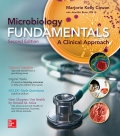
(a)
To determine:
The characteristics of viruses that could be used to characterize them as life forms.
Introduction:
Viruses are defined as the biological agent that is able to reproduce inside the cell of living host. After infection, the host cell produces thousands of identical copies of viruses. They can infect all living organisms such as animals, plants, microorganisms, and humans.
(a)
Explanation of Solution
The virus is defined as non-cellular organisms which is composed of genetic material such as either DNA or RNA and protein. They have the ability to invade in living cells. Viruses are considered as both living and non-living organisms. The general characteristics of viruses are as follows:
(a) Viruses are enclosed within a protective envelope which is made of lipoprotein.
(b) Viruses are composed of viral protein coat which is called as capsid and capsid and envelope are responsible for infection in the host.
(c) They are composed of spikes that help in the attachment of viruses with the host cell.
(d) They have to ability to reproduce and form multiple copies inside the host cell.
(e) Viruses may contain either DNA or RNA as their genetic material.
(f) Viruses are active and considered as living cells when they are inside their host.
(b)
To determine:
The viruses make them lifeless molecule.
Introduction:
Viruses are defined as the biological agent that is able to reproduce inside the cell of living host. After infection, the host cell produces thousands of identical copies of viruses. They can infect all living organisms such as animals, plants, microorganisms, and humans.
(b)
Explanation of Solution
Viruses are non-cellular
Want to see more full solutions like this?
Chapter 5 Solutions
EBK MICROBIOLOGY FUNDAMENTALS: A CLINIC
 Human Anatomy & Physiology (11th Edition)BiologyISBN:9780134580999Author:Elaine N. Marieb, Katja N. HoehnPublisher:PEARSON
Human Anatomy & Physiology (11th Edition)BiologyISBN:9780134580999Author:Elaine N. Marieb, Katja N. HoehnPublisher:PEARSON Biology 2eBiologyISBN:9781947172517Author:Matthew Douglas, Jung Choi, Mary Ann ClarkPublisher:OpenStax
Biology 2eBiologyISBN:9781947172517Author:Matthew Douglas, Jung Choi, Mary Ann ClarkPublisher:OpenStax Anatomy & PhysiologyBiologyISBN:9781259398629Author:McKinley, Michael P., O'loughlin, Valerie Dean, Bidle, Theresa StouterPublisher:Mcgraw Hill Education,
Anatomy & PhysiologyBiologyISBN:9781259398629Author:McKinley, Michael P., O'loughlin, Valerie Dean, Bidle, Theresa StouterPublisher:Mcgraw Hill Education, Molecular Biology of the Cell (Sixth Edition)BiologyISBN:9780815344322Author:Bruce Alberts, Alexander D. Johnson, Julian Lewis, David Morgan, Martin Raff, Keith Roberts, Peter WalterPublisher:W. W. Norton & Company
Molecular Biology of the Cell (Sixth Edition)BiologyISBN:9780815344322Author:Bruce Alberts, Alexander D. Johnson, Julian Lewis, David Morgan, Martin Raff, Keith Roberts, Peter WalterPublisher:W. W. Norton & Company Laboratory Manual For Human Anatomy & PhysiologyBiologyISBN:9781260159363Author:Martin, Terry R., Prentice-craver, CynthiaPublisher:McGraw-Hill Publishing Co.
Laboratory Manual For Human Anatomy & PhysiologyBiologyISBN:9781260159363Author:Martin, Terry R., Prentice-craver, CynthiaPublisher:McGraw-Hill Publishing Co. Inquiry Into Life (16th Edition)BiologyISBN:9781260231700Author:Sylvia S. Mader, Michael WindelspechtPublisher:McGraw Hill Education
Inquiry Into Life (16th Edition)BiologyISBN:9781260231700Author:Sylvia S. Mader, Michael WindelspechtPublisher:McGraw Hill Education





